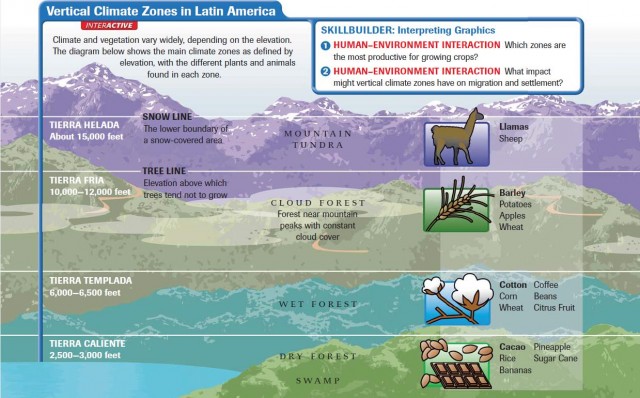Latin America: Climate and Vegetation
A HUMAN PERSPECTIVE In the 17th century, missionaries and Indians in the area of present-day Paraguay were at times attacked by jaguars, the great cats of Latin America. In 1637, packs of jaguars roamed the countryside, attacking humans. The Indians built barricades for protection from the savage cats. But the jaguars remained a source of fear. The cats were a factor that had to be taken into account in settling and protecting towns and villages. There was no question about it—jaguars and other creatures thrived in the humid climate and thick vegetation of the tropical rain forests.
A Varied Climate and Vegetation
The climate of Latin America ranges from the hot and humid Amazon River basin to the dry and desert-like conditions of northern Mexico and southern Chile. Rain forest, desert, and savanna are all found in the region.
The vegetation varies from rain forests to grasslands and desert scrub. It ranges from the thick trees of the rain forests to mosses of the tundra. This variety of climate and vegetation is due to several factors. First, Latin America spans a great distance on each side of the equator. Second, there are big changes in elevation because of the massive mountains in the region. Third, the warm currents of the Atlantic Ocean and the cold currents of the Pacific Ocean affect the climate.

Tropical Climate Zones
The tropical climate zones of the region produce both rain forests and the tree-dotted grasslands known as savannas. Rain forests are abundant in Central America, the Caribbean, and South America. Savannas are found in South America.
TROPICAL WET
Rain forests are dense forests made up of different species of trees. They form a unique ecosystem—a community of plants and animals living in balance. The climate in these areas is hot and rainy year round. The largest forest is the Amazon rain forest, which covers more than two million square miles of South America. Much of this rain forest is located in Brazil.
Rain forests contain many exotic plants and creatures. Scientists have counted more than 2,500 varieties of trees in the Amazon rain forest. These include the Brazil nut tree, which grows 150 feet high. Animals include the anaconda, among the largest snakes in the world, the jaguar, and the piranha, a sharp-toothed, meat-eating fish.
TROPICAL WET AND DRY
Wet and dry climates, found primarily in South America, support savannas, which are grasslands dotted with trees common in tropical and subtropical regions. These areas have hot climates with seasonal rain. Savannas are found in Brazil, Colombia, and Argentina.
Dry Climate Zones
Dry climate zones are found in Mexico on the North American continent and in various countries of South America. Neither Central America nor the Caribbean, though, has dry climate zones.

SEMIARID
A semiarid climate is generally dry, with some rain. Vast, semiarid, grass-covered plains are often found in such climates. Desert shrubs also grow in semiarid regions. Such regions are found in Mexico, Brazil, Uruguay, and Argentina.
DESERT
Parts of northern Mexico are classified as desert, as is much of the coast of Peru. The Atacama Desert is in northern Chile. Likewise, Argentina's southern zone, Patagonia, contains a desert. The deserts of the region are made up of shrubs growing in gravel or sand.
Mid-Latitude Climate Zones
The mid-latitude, moderate climate zones in the region are located south of the equator, from approximately Rio de Janeiro in Brazil southward.
HUMID SUBTROPICAL
Humid subtropical areas have rainy winters and hot, humid summers. Parts of Paraguay, Uruguay, southern Brazil, southern Bolivia, and northern Argentina (including Buenos Aires) are located in humid, subtropical climates. The vegetation is varied.
MEDITERRANEAN
Mediterranean climate zones experience hot, dry summers and cool, moist winters. Part of Chile along the west coast is in this zone. You have experienced a similar climate if you have ever been to California. The vegetation in this climate is mainly chaparral.
MARINE WEST COAST
Marine west coast climate zones are characterized by cool, rainy winters and mild, rainy summers. One such climate region runs along the coast of southwestern South America. Parts of southern Chile and Argentina have this climate. If you have spent time in Oregon or Washington, you have experienced this type of climate. Forests are the typical vegetation.
HIGHLANDS
Highland climate zones vary from moderate to cold, depending on elevation. Other factors influence highland climates, such as wind, sunlight, and landscape. Highland climates are found in the mountains of Mexico and South America. In the next section, you will read about how human-environment interaction affects the quality of life in Latin America.